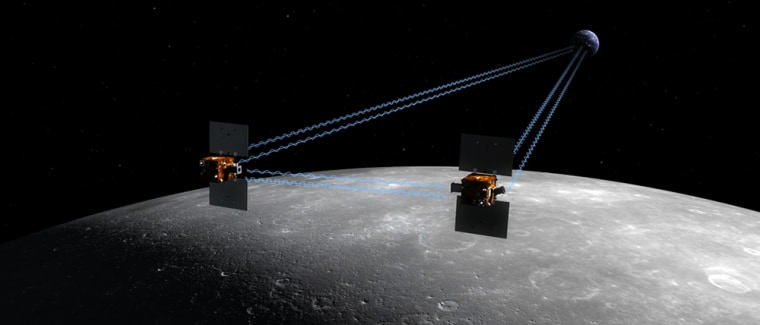As if scanning the moon's surface for impact blemishes were not enough, NASA now plans to visualize its internal imperfections to solve longstanding mysteries about the moon's insides.
NASA said this week that it selected the Gravity Recovery and Interior Laboratory, or GRAIL, from two dozen mission proposals. GRAIL's twin spacecraft are slated to launch around Sept. 6, 2011. After a few weeks of settling into orbit, the probes would map the lunar gravity field for 90 days.
Scientists hope to use the data to pick apart its insides from crust to core, much like a medical X-ray that shows the insides of a person.
"We're looking forward to the data," Michael New, GRAIL's lead project scientist, told Space.com. "It's really going to open up new understanding of the particular history and internal structure of the moon."
NASA previously launched a mission to map Earth's gravitational fields, called GRACE — the Gravity Recovery and Climate Experiment. Over the years, it measured minute differences in gravitational pull at different points around our planet, revealing glacial melt, migrating magma and tectonic plate movement, among other curiosities.
Similarly, GRAIL will measure gravity at different points around the moon, which should reveal any gravity differences as slight as 1 million times weaker than Earth's overall gravity.
New said the data will be about 1,000 times better than any other measurements of lunar gravity, explaining that such data can be processed to peer beneath the moon's surface and locate any significant structures related to early lunar history.
"We're talking about things like relaxation of lunar crust to ... a big lava flow," New said. "The other thing that may become a little clearer will be a little bound on the size of any lunar core, if there is one."
Besting the competition
GRAIL beat out 23 elaborate competitors in NASA's Discovery mission selection process, and will cost at least $375 million for the whole package — design, launch and staffing included.
"GRAIL also offers to bring innovative Earth studies techniques to the moon as a precursor to their possible later use at Mars and other planets," Alan Stern, NASA's associate administrator for science, said at this week's American Geophysical Union's 2007 meeting.
New said the money is set aside in NASA's budget, which means intricate engineering of GRAIL's twin spacecraft can begin.
"The money's there," he said. "Unless something really horrific happens — like another Katrina — we have money in our budget to support mission all the way out."
The Lunar Reconnaissance Orbiter, set to launch in 2008, will precede GRAIL's spaceshot. LRO will scan the moon's pockmarked surface for future robotic and human landing sites and will be accompanied by another spacecraft, the Lunar Crater Observation and Sensing Satellite, which will impact the lunar south pole to search for polar water.
"As NASA moves forward with exploration endeavors, our lunar science missions will be the light buoy leading the path for future human activities," said Jim Green, NASA's planetary division director in Washington.
Lockheed Martin Space Systems in Denver will build GRAIL, and NASA's Jet Propulsion Laboratory in Pasadena, Calif., will manage the mission.
